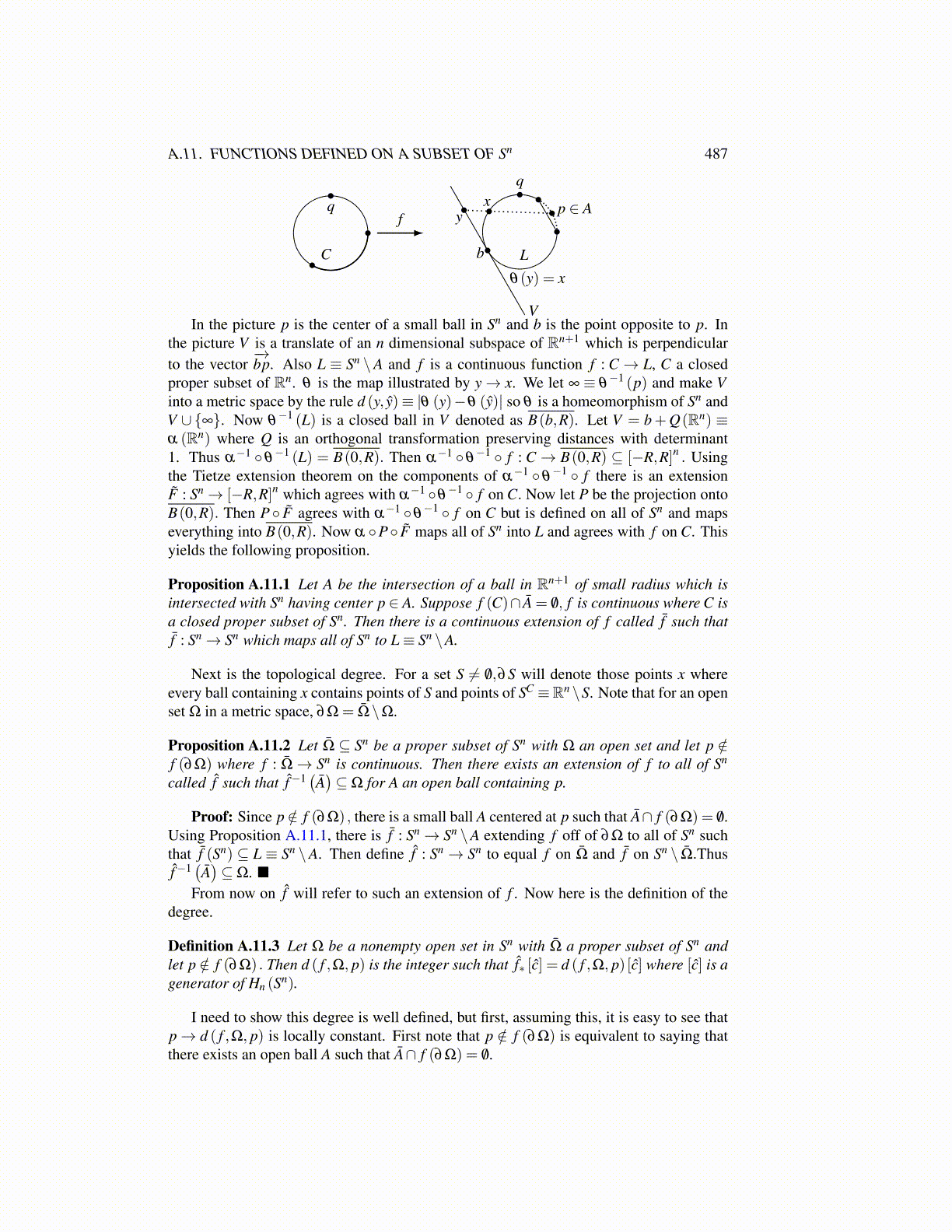
A.11. FUNCTIONS DEFINED ON A SUBSET OF Sn 487
q
C
f
q
b
x
θ(y) = x
V
L
p ∈ Ay
In the picture p is the center of a small ball in Sn and b is the point opposite to p. Inthe picture V is a translate of an n dimensional subspace of Rn+1 which is perpendicularto the vector
−→bp. Also L ≡ Sn \A and f is a continuous function f : C→ L, C a closed
proper subset of Rn. θ is the map illustrated by y→ x. We let ∞ ≡ θ−1 (p) and make V
into a metric space by the rule d (y, ŷ)≡ |θ (y)−θ (ŷ)| so θ is a homeomorphism of Sn andV ∪{∞}. Now θ
−1 (L) is a closed ball in V denoted as B(b,R). Let V = b+Q(Rn) ≡α (Rn) where Q is an orthogonal transformation preserving distances with determinant1. Thus α−1 ◦ θ
−1 (L) = B(0,R). Then α−1 ◦ θ−1 ◦ f : C→ B(0,R) ⊆ [−R,R]n . Using
the Tietze extension theorem on the components of α−1 ◦ θ−1 ◦ f there is an extension
F̃ : Sn→ [−R,R]n which agrees with α−1 ◦θ−1 ◦ f on C. Now let P be the projection onto
B(0,R). Then P ◦ F̃ agrees with α−1 ◦ θ−1 ◦ f on C but is defined on all of Sn and maps
everything into B(0,R). Now α ◦P◦ F̃ maps all of Sn into L and agrees with f on C. Thisyields the following proposition.
Proposition A.11.1 Let A be the intersection of a ball in Rn+1 of small radius which isintersected with Sn having center p ∈ A. Suppose f (C)∩ Ā = /0, f is continuous where C isa closed proper subset of Sn. Then there is a continuous extension of f called f̄ such thatf̄ : Sn→ Sn which maps all of Sn to L≡ Sn \A.
Next is the topological degree. For a set S ̸= /0,∂S will denote those points x whereevery ball containing x contains points of S and points of SC ≡Rn \S. Note that for an openset Ω in a metric space, ∂Ω = Ω̄\Ω.
Proposition A.11.2 Let Ω̄ ⊆ Sn be a proper subset of Sn with Ω an open set and let p /∈f (∂Ω) where f : Ω̄→ Sn is continuous. Then there exists an extension of f to all of Sn
called f̂ such that f̂−1(Ā)⊆Ω for A an open ball containing p.
Proof: Since p /∈ f (∂Ω) , there is a small ball A centered at p such that Ā∩ f (∂Ω) = /0.Using Proposition A.11.1, there is f̄ : Sn→ Sn \A extending f off of ∂Ω to all of Sn suchthat f̄ (Sn) ⊆ L ≡ Sn \A. Then define f̂ : Sn → Sn to equal f on Ω̄ and f̄ on Sn \ Ω̄.Thusf̂−1(Ā)⊆Ω. ■
From now on f̂ will refer to such an extension of f . Now here is the definition of thedegree.
Definition A.11.3 Let Ω be a nonempty open set in Sn with Ω̄ a proper subset of Sn andlet p /∈ f (∂Ω) . Then d ( f ,Ω, p) is the integer such that f̂∗ [ĉ] = d ( f ,Ω, p) [ĉ] where [ĉ] is agenerator of Hn (Sn).
I need to show this degree is well defined, but first, assuming this, it is easy to see thatp→ d ( f ,Ω, p) is locally constant. First note that p /∈ f (∂Ω) is equivalent to saying thatthere exists an open ball A such that Ā∩ f (∂Ω) = /0.